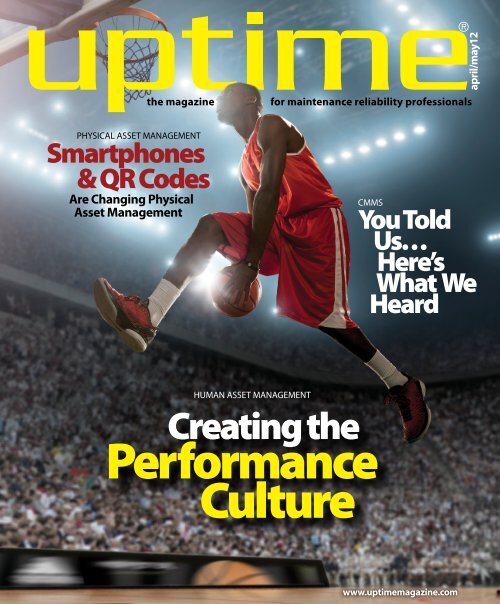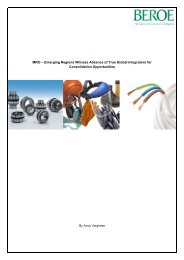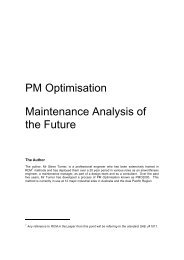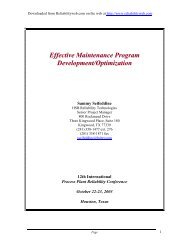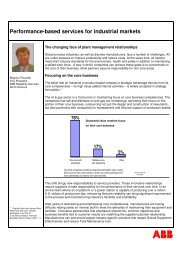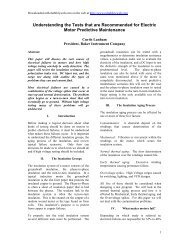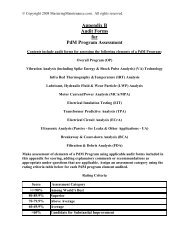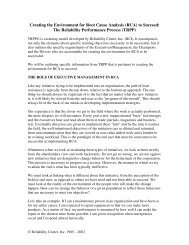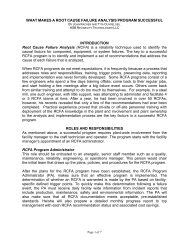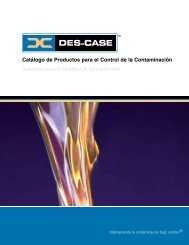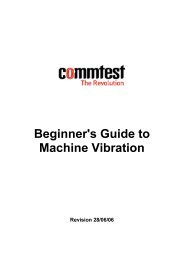Performance Culture - ReliabilityWeb.com
Performance Culture - ReliabilityWeb.com
Performance Culture - ReliabilityWeb.com
You also want an ePaper? Increase the reach of your titles
YUMPU automatically turns print PDFs into web optimized ePapers that Google loves.
INDUSTRIAL PRESS INC.#1 IN MAINTENANCE AND RELIABILITY!GROUNDBREAKING NEW TITLES!IS MY MACHINE OK?A FIELD GUIDE TO ASSESSING PROCESS MACHINERYRobert X. Perez and Andrew P. Conkey 2012, 300 pages, Illus., ISBN 978-0-8311-3440-2, $29.95This handy guide for assessing the potential risk of failure offers a solid basis for reliable and safe machinery operation. Combiningthe most <strong>com</strong>monly used assessment tools into one source, it is meant to be taken into the field by operators, plant supervisors,maintenance personnel, and reliability professionals in order to make informed decisions about their equipment.Features: The only reference available that assembles a body of sound operating practices. Includes guidelines for gaugingmachine maladies, such as vibration and pulsation. Provides guidelines for key machine factors, such as lubrication condition,temperature limits, alignment, and balance standards. Presents numerous relevant examples within each section aimed at helping readers understandthe proper application of the various assessment methodologies.THE RCM SOLUTIONNancy Regan 2012, 256 pages, Illus., ISBN 978-0-8311-3424-2, $49.95A how-to generic approach, with minimal theory. Offers a basic, <strong>com</strong>mon sense approach to RCM. Major coverage of SAEJA1011 <strong>com</strong>pliant RCM. Presents detailed processes to use when RCM doesnt apply. Overall, a total solution for implementingRCM for any type of organization.Table of Contents: Introduction to Reliability Centered Maintenance (RCM). Introduction to The RCM Solution. Facilitated WorkingGroup approach. Reliability Centered Maintenance. The RCM Solution. Task Synchronization. Analysis Validation. Implementation. The Use ofSoftware. How to Start - and successfully maintain - an RCM program. Preparing for an Analysis. The Power of RCM. Common Misconceptions ofRCM. An Introduction to Facilitation. Participative Problem Solving: A Working Group Approach to Formulating Valuable Solutions.EFFECTIVE MAINTENANCE MANAGEMENT, SECOND EDITIONV. Narayan 2011, 375 pages, Illus., ISBN 978-0-8311-3444-0, $49.95This <strong>com</strong>pletely updated edition and unique guide examines the role of maintenance in minimizing the risks relating to safety orenvironmental incidents, adverse publicity, and loss of profitability.Features: New coverage of Risk-Based Inspection and Instrumented Protective Functions. Accounts of the Longford (1998),Columbia (2003) and Sayano-Shushenskaya (2009) disasters reinforce the evidence for the event escalation theory explained in chapter9. Two new chapters on Information for Decision Making and Improving System Effectiveness.COMPLETE GUIDE TO PREVENTIVE & PREDICTIVE MAINTENANCE, SECOND EDITIONJoel Levitt 2011, 398 pages, Illus., ISBN 978-0-8311-3441-9, $49.95As the first resource to give true emphasize to the four aspects of success in preventive maintenance systems this new edition sharesthe best practices, mistakes, victories, and essential steps for success.Features: Includes check sheets, history of PM, stories, photographs, and case histories. Contains a glossary of terms. Providessample task lists for a variety of equipment with some of the logic behind each task. Offers templates for developing your owntasking. Includes protocols for detailed economic analysis with examples.GO TO WWW.INDUSTRIALPRESS.COM TO SEE MORE MAINTENANCE TITLES.ORDER ONLINE, BY PHONE, OR BY FAX AND RECEIVE A 25% DISCOUNT ON ADVERTISED TITLES. *BE SURE TO PROVIDE SPECIAL OFFER #UPAM-12 AT CHECKOUT.*OFFER EXPIRES 5/31/12 AND IS AVAILABLE TO U.S. RESIDENTS ONLY.INDUSTRIAL PRESS INC.989 Avenue of the Americas, 19th Floor • New York, NY 10018 • Phone (212) 889-6330 • Toll-Free in U.S. (888) 528-7852Fax (212) 545-8327 • www.industrialpress.<strong>com</strong> • E-mail: info@industrialpress.<strong>com</strong>
7sus on action plans will eliminate a lot offalse starts. Doing things once, doing themright and eliminating root cause will helpassure every other part of the <strong>Performance</strong><strong>Culture</strong>.• Variability in manufacturing operations is afact of life. It takes many forms, includingcustomer demand, operating speeds, processand equipment parameters, materialsand finished product. Variability in anyform produces waste, and as variability increases,performance is adversely affected.It affects the operation in one or more ofthe following ways:◊ Lost throughput◊ Wasted capacity◊ Inflated cycle time◊ Larger inventory levels◊ Long lead times and/or poor customerservice.CASE STUDYWe worked with the oil and gas productionoperations of a European-based oil major toachieve three goals:1. Improve production output;2. Reduce costs;3. Improve asset integrity within the existingoperating budget, asopposed to special studies and interventions.The vehicle was through improved maintenanceand controls within their managingsystem. When we began our work, their <strong>Performance</strong><strong>Culture</strong> analysis summary showed themeasurements shown in Figure 4.The <strong>com</strong>pany was regarded as a first quartileoperator in its industry—demonstrating howlow the bar is for this industry when you seethe huge opportunity for improvement demonstratedby this “spider-diagram.”The issues demonstrated in the 12 elements ofthe <strong>Performance</strong> <strong>Culture</strong> were:1. Meets Its Numbers - Despite being a topquartile performer in the categories of productionloss and operating expense, bothof these highly important metrics weretrending in the wrong direction.2. Satisfies Customers - Increasing unplannedproduction losses were causing occasionallymissed customer nominations at exportpoints.3. Continuously Improves – The organizationhad ongoing improvement initiatives, butthese projects required a substantial “push”There was no understanding of the value of implementingthese practices and disciplines. Was SAP PMimplementation an exercise of some administrativemandate, or was this a business imperative, leavinghundreds of millions of dollars on the table?Figure 4: <strong>Performance</strong> <strong>Culture</strong>Spider Chart - Pre-Implementationeffort from the staff to engage the field.There were far too many to attend to andmost showed no progress at all.4. Develops Employees – Individual and positiondevelopmental plans existed alongwith significant training resources. Althoughthese were in place, there was ahigh level of under-utilization of trainingand personal development resources.5. Focuses Energy – The organization wasdata and information rich. However, therewas insufficient focus on the critical fewparameters that were driving productionand expense.6. Creates Trust – A low level of trust existedbetween the field staff and office staff. Thiswas primarily the result of multiple “high”priority initiatives that would start/stop,were chronically under resourced and usuallyhad little follow through and no accountability.7. Lives Its Values – The organizational valueswere clearly <strong>com</strong>municated and largely exhibitedwith occasional exceptions.8. Embeds Vision and Goals – Goals and objectiveswere <strong>com</strong>municated in the organizationfrom the top down. However, goalswere not uniformly cascaded down intothe organization. This created misalignmenton the asset and regional levels withtop-level goals.9. Wins with Teamwork – Although subtle,the organization was “siloed” in severalways. Territorial divisions existed betweenfunctional organizations (i.e., operations,maintenance, logistics, procurement, etc.),as well as the field versus the office staff.Some teamwork was exhibited at the assetlevel within functional organizations.10. Assures Safety and Integrity – There wasa high focus on safety, health and environmentalissues. Safety-critical work alwaysreceived the highest priority and safetyperformance was high.


